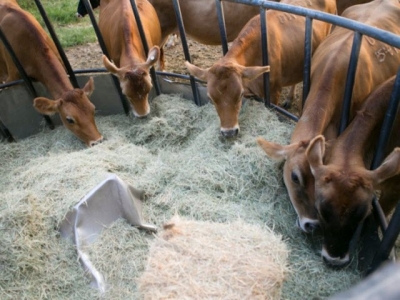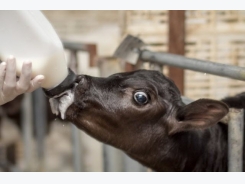Feed efficiency improvements boost dairy sustainability

Nutritionists have a role to play in reducing the environmental footprint of the dairy industry, says researcher.
Researchers at Virginia Tech examined how improving the efficiency of energy and protein use in dairy cattle feed benefits land use, water use and greenhouse gas emissions (GHG) involved in production.
“There are a lot of misconceptions about environmentally friendly animal agriculture (among consumers, scientists, producers, policy makers etc.) and a part of that misunderstanding stems from a lack of detailed, reliable evaluations of the environmental impact of products,” said corresponding researcher Robin White. “The primary interest in the dairy study, for me, was to highlight the potential impact that dairy nutrition research has on opportunities to improve sustainability of animal agriculture.”
“We identified that much of the work we do as animal nutritionists (attempting to find strategies to improve feed efficiency) may greatly help to enhance sustainability of dairy production systems,” she told FeedNavigator.
The group’s study examined a series of farm-scale diets optimized to reduce land use, water use or greenhouse gas emissions by dairy producers. It also addressed the role that feed efficiency in terms of energy and protein use could play.
The goals of the research project included designing a whole-farm diet optimization model to highlight ways to reduce the use of land and water along with GHG released, and, to assess what role improving feed efficiency could play, researchers said in the paper.
The hypothesis being tested was that improving energy and protein use efficiency would also reduce the environmental footprint of dairy production.
The group found that improving the feed efficiency in terms of energy and protein use offered a way to improve environmental results without limiting the profitability of the dairy, the researchers said.
“Improved feed efficiency can greatly improve the environmental impact of dairy operations,” White said. “Feed efficiency should be a focus on management and, if possible, energy and protein use efficiency should be more thoroughly considered when designing and evaluating diets.”
Why environmental focus?
As global population expands, the expectation is that interest in meat and milk also will increase, said the researchers.
Improving animal nutrition is one way to increase the sustainability of ruminant production, they said. However, within much of the work done on dairy production emphasis focuses on improving one factor, like reducing nitrogen (N) excretion or reducing phosphorus or ammonia emissions.
At times the single element focus may mean poorer results for other environmental metrics, they said. Examining a whole farm model paints a more complete picture of environmental influence of dairy farm management.
Previous modeling systems have focused on ways to improve energy- and protein-use efficiency, said the researchers said in the study. But, less work has been done to extend those influences into considering reduction of the environmental footprint.
Dairy producers have long been involved in promoting environmentally sustainable animal agriculture, said White. Their production system converts “human inedible feed” into edible protein, and must function in a manner that does not damage the land, animals or natural resources.
“Over the last 60 years, US dairy production has dramatically reduced the carbon footprint and resource use of our milk production system,” she said. “Part of the reason we conducted the analysis on efficiency was to further support that idea. As dairy producers become more efficient, they help to enhance the environmental sustainability of their businesses, generally without compromising profitability.”
Study details
In the trial, a model was established to quantify diet cost, land use, water use and GHG emissions related to US dairy production in one-year increments, said the researchers. The system considered cattle population, weight, dry matter intake, nutrient requirements and feed composition.
Twenty-eight scenarios were run and five were modeled to examine options to reduce environmental influence of dairy production, they said. The scenarios included one for least dietary cost (LC), looking to reduce land use (LL10), water use (LW10) or GHG (LG10) and one with multiple objectives.
A series of situations was also examined with tightened economic controls for feed costs, they said.
The influence of improving nutrient-use efficiency were assessed for environmental and economic benefit for situations with boosted energy, protein or energy and protein use efficiency, they said. Net energy and metabolizable protein needs were established and diets evaluated were balanced monthly.
Animal eliminations also were part of the environmental calculations, as were the amount of on-farm production for forages, hays and silages, the researchers said. Feed crop GHG emission were calculated from cropping to the feed mill.
Results
The LC diet was used to set baseline levels, and some results were comparable to previously established metrics, the researchers said. Cost was slightly lower as feed crops were evaluated in different years, land use was slightly below as the feed relied on by-product ingredients, and water and GHG amounts were within the established ranges.
The group found that options exist to improve the environmental sustainability of dairy production in terms of land and water use and GHG emission with minimal on-farm cost increases, they said. Increasing energy and protein efficiency helped lower costs while making environmental improvements.
When calculations were run for land use environmental improvements were also seen for water and GHG emissions, while focusing on feed cost altered the items included, they said.
A 5% increase in feed cost reduced environmental effect by 12.3%, while a 10% feed cost increase resulted in a 19.1% decrease in footprint, the researchers said. There was a diminishing return as cost increased.
However, if both feed energy and protein use efficiency were improved by 15%, with a 1% cost increase for feed, environmental improvement was 14.7%, they said.
Results found in the analysis were in keeping with what group members thought they would find, except that there was a large opportunity to improve overall environmental influence, said White.
“Dairy production systems typically rely on a large variety of potential feedstuffs and as a result, they have greater opportunity to enhance environmental impact,” she said. “This is partially what is driving the lack of tradeoffs between environmental impact metrics.”
Work with beef production demonstrated tradeoffs among the environmental objectives, she said. “Because dairy producers rely on a wider variety of feeds and more byproduct feeds, the diversity of feeds also conveys a diversity of environmental impact and allows us to design diets with concurrent improvements in multiple environmental objectives,” she added.
There also are several potential management practices that could be used to improve efficiency, said White.
“For example, diet can be manipulated to optimize protein and energy use efficiency, feeding methods can be adapted to reduce feed wastage, feeds can be processed differently to enhance digestibility, etc,” she said. “Almost any practice that improves feed efficiency will enhance opportunities to improve land use, water use, and greenhouse gas emissions of dairy production systems.”
Looking forward
Currently the group is working to evaluate the National Research Council (2001) model for dairy producers to establish potential biases in the model, said White. The goal will be to find and address those items so diets can be more precisely designed for lactating cows.
“Along that line, we are attempting to define amino acid requirements for dairy cattle so we can begin to balance rations on an amino acid basis, rather than a protein basis,” she said.
Additionally, the group is in the early stages of assessing for improvement energy supply models, she said. “We are planning a series of experiments to better understand how diet drives energy (volatile fatty acid) production and absorption so we can improve representations of energy supply in nutrient requirement models,” she added.
There also could be promise in genetic research being done to address feed efficiency through tracking cattle feed intake, said White. “I believe the idea was to put together a package of selection tools for deployment and depending on how well animals phenotypically changed under selection regimens, I imagine this could be a very promising way forward,” she added.
Có thể bạn quan tâm
Phần mềm

Phối trộn thức ăn chăn nuôi

Pha dung dịch thủy canh

Định mức cho tôm ăn

Phối trộn phân bón NPK

Xác định tỷ lệ tôm sống

Chuyển đổi đơn vị phân bón

Xác định công suất sục khí

Chuyển đổi đơn vị tôm

Tính diện tích nhà kính

Tính thể tích ao hồ



 Volatile fatty acids boosts calf growth, rumen development
Volatile fatty acids boosts calf growth, rumen development  Supplemental solids boost dairy heifer early growth
Supplemental solids boost dairy heifer early growth